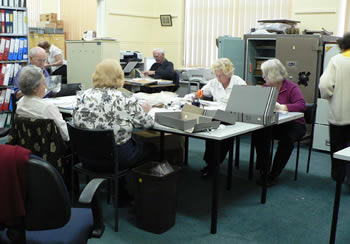The main purpose of the project became a way to describe the research I was undertaking in a way that would teach others how to do the same in order to write their own local history. The written project that I have created with and for The Ku-Ring-Gai Historical Society (KHS) has developed from my original proposal and is still a work in progress that I am undertaking.
My time with the KHS has been spent with the land history group that meets on Tuesdays and with the team on Wednesday that digitizes, records and organises the historical collections of the society. I have been learning how to research local history through the resources of the society, being taught how to use public records to research and assisting with the mailing out of the society’s journal publication called “The Historian”. I have also assisted in adding to archives on property history and have helped with the digitization of some photographs for the society’s collections.
One of the challenges that was part of the reason that I wanted to work with the KHS was because everyone there is much older than me, most well over seventy years old. It is made up of retirees and for many is a source of community as well as being a hobby to involve themselves in. It has meant I have had a wealth of knowledge and experience to draw upon either through informal chats or from showing me relevant materials. It has also meant my understanding of technology and social media and general physical ability has been of use on some occasions.
In my proposal I stated that I wanted to write three articles for the KHS journal “The Historian” that focused on local history concerning specific areas of the suburb that was being covered in the next publication. I was also going to attach a summary of the research and ways that I used sources to write the articles. As I began my research, I recorded what I was drawing upon from my own research skills, but I found I needed to be taught how to navigate specific collections and how to interpret and understand some of the new types of sources I was being introduced to such as land titles. This was not particularly easy for me and it took me a lot longer to do my research than I had originally expected.
I became aware that a concern for the society was that there had been a significant decline in the amount of contributions to the “The Historian” for recent editions and that they had even been reprinting articles from much older issues to fill up space. I had a meeting with a family friend who had written an article for the society a few years ago as I wanted to know how they had undertaken research. She had to learn many more skills than I did, and it took her several months to properly research and write the single article. We spent a good part of the conversation discussing the large amount of digitization of sources online and how while they could be tricky to navigate, they made research much easier and more efficient.
What has also become clear in my time at the KHS is that they want more involvement from people, both from its current members as well as hoping for more interest from the wider community. I wanted to make this project about making it easier for someone who may be interested but may not know how to start their research of local history. I am not an expert in researching and writing local history and I have not really been a member of the KHS for long enough to be able to state the exact value and expectations, but what I do hope to demonstrate is a path for others to be able to follow. The project also tries to draw attention to the collections and types of resources that the society has and recognizes both the journal publication as well as specific research undertaken by the society. I want to present this project as a draft to the society in the hopes that it can be edited and added to in a more collaborative way and could hopefully be able to entice someone to try writing local history who may not have thought they could before.
For it to get to that stage it will need a lot more work and it would be required to go through some stages of review with the committee members before it could be used as an internal resource. There is still a lot more to add, including finishing the articles themselves so that a more holistic explanation of the process from beginning to end can occur. I would also need a lot of guidance from other members of the society on additional avenues of historical research that I may not have discovered yet.
This project has challenged me to engage in a community that records and researches local history and to think about the way that we record and describe the people and places that are continually changing. I want to finish this project in the next few months as I can see the value and the potential of it to benefit the society in the long-term and I would be very excited to see anything I had written being published in their journal.

